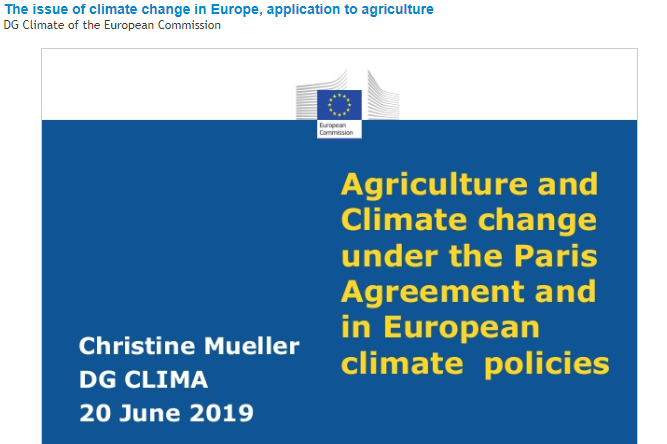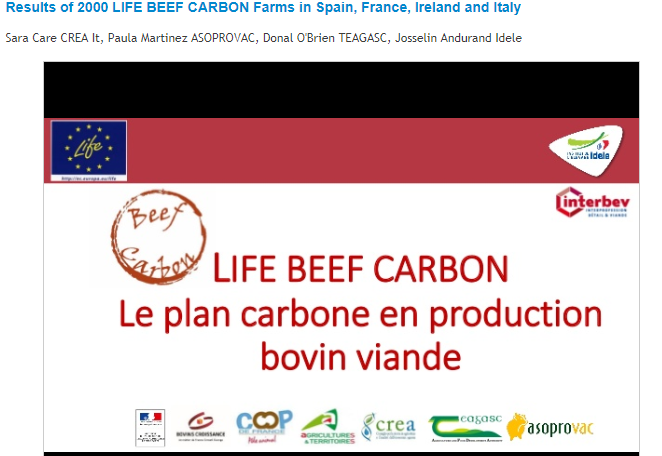LIFE BEEF CARBON 3rd EU network
Beef stakeholders, policy makers, academics, non-governmental organizations, and customers from across Europe met on the 20th of June for the third LIFE BEEF CARBON network event. The event was hosted by IDELE in the FIAP Jean Monnet centre in Paris and supported by national and international partners. Attendants were presented the latest European Climate policy for agriculture and the LIFE BEEF CARBON action plans for innovative farms along with new livestock initiatives to reduce carbon emissions and improve sustainability.


Bruno Dufayet, president of the national confederation of livestock in France, opened the network by outlining livestock’s contribution to carbon or greenhouse gas emissions. The president highlighted the findings from the Food and Agriculture Organization (FAO) e.g., Livestock Long Shadow report that livestock are a key source of agricultural carbon emissions, but noted that livestock production needs to increase to fulfil the United Nations (UN) food security ambitions.
Christine Mueller, European Commission DG Clima, re-iterated agriculture and livestock’s contribution to carbon emissions and climate change. She presented the EU carbon reduction emissions targets designed to prevent a 2⁰C increase in global temperature by the end of this century. For agriculture, Christine showed the sector will need to reduce current (2018) carbon emissions by over 50% (>200 mega tonnes of CO2) by 2050 and outlined potential mitigation options as well as the UN Koronivia work on agriculture.
An overview of LIFE BEEF CARBON, CARBON DAIRY, Teagasc Marginal Abatement Cost Curve, Origin Green and further programmes to reduce Europe’s livestock carbon footprint (carbon emissions/unit of output) was provided by Jean Baptiste Dolle, Head of IDELE Environment Department. The agriculture and environment expert showed that European agriculture has maintained the same level of livestock production and reduced emissions by 18% since 1990. He highlighted that further improvement of livestock’s footprint is possible by adopting actions from the initiatives discussed along with the 4 per 1000 soil initiative.
LIFE BEEF CARBON demonstrative farm observatory and innovative farms were jointly presented by Josselin Andurand (IDELE), Sara Care (CREA), Paula Martinez (ASOPROVAC) and Donal O’Brien (Teagasc). The researchers presented the predominant beef farming systems sampled in each country along with the farmers and technicians trained, the methodology and tools applied to quantify carbon footprint and carbon action plans. The latter indicated that simultaneously improving several farm productivity measures (e.g., reducing age at first calving) can cut beef carbon footprint by up to 15% and improve economic performance regardless of the type of beef system. Further mitigation may be possible by enhancing carbon sequestration (e.g., planting hedgerows) and by using new low emission technologies. In addition, these options have additional environmental benefits e.g., reducing ammonia emissions, but financial cost can be a barrier to there implementation. Nevertheless, the actions innovative farms have demonstrated to mitigate beef carbon footprint are increasing beef farmers understanding of carbon emissions and are gradually being adopted.
France’s new low carbon label may accelerate the rate of adoption of farm efficiency and carbon sequestration measures via potentially providing carbon credits to farmers. Jean Baptiste Dolle presented the labels requirement regarding verification of carbon emission reductions on farm and outlined the companies and/or institutions that are interested in financing carbon credits. The label may also aid the role out of a low carbon action plan for the beef sector. The latter will be discussed at the final LIFE BEEF CARBON EU network in Ireland later this year. The venue and date is TBD.
